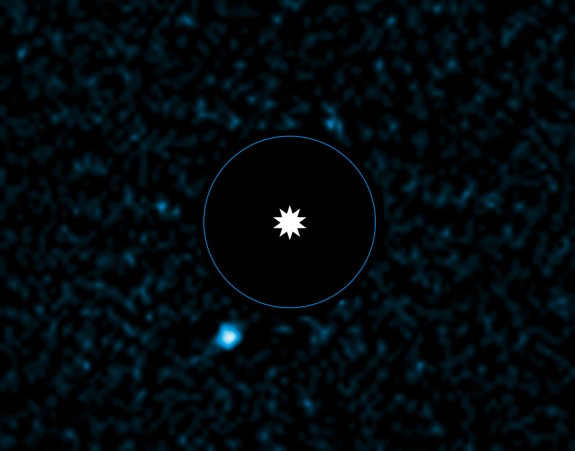This Is an Actual Photo of a Planet in Another Solar System
This is a planet, 300 light years away, as seen through the Very Large Telescope

The little blue splotch is the planet HD95086 b. It’s about four or five times the mass of Jupiter and it orbits a star 300 light years away. The planet’s star doesn’t actually look like a clip art star–the astronomers had to cover the star so they could see the comparatively faint planet. Photo: European Southern Observatory
See that little blue smudge? That’s another planet.
It’s named HD95086 b, and it’s orbiting a star 300light years away. This is one of the first times in human history that we’ve ever laid eyes on a planet in another solar system, a planet that isn’t orbiting the Sun.
Thanks to the Kepler telescope we know that thousands, perhaps billions of planets exist out there in the universe. But we haven’t actually seen very many of them. Kepler found planets by looking for the absence of starlight—it registered a planet’s presence when the light from a star dipped, as a planet passed in front. Other techniques let astronomers measure the presence of a planet by calculating how the star wobbles because of the gravitational pull of the orbiting planet. But this is different. The photo above is of a planet in a different solar system as seen through a telescope.
It’s really, really hard to see planets like this one directly. You need a big, advanced telescope. To see HD95086 b, astronomers with the European Southern Observatory used the Very Large Telescope. (Yes, that’s its real name.) The movement of the atmosphere, which a telescope on the ground needs to look through, can perturb the view. The Very Large Telescope is equipped with adaptive optics, a way for the instruments to account for the atmospheric distortion and clean up the image. The astronomers also used a technique to bump up the contrast so that they could see the faint planet.
According to Elizabeth Howell for Universe Today, the new planet is around four or five times as big as Jupiter and orbits its star at a distance about twice the distance between the Sun and Neptune. The star itself, says Howell, is a “baby” compared to the Sun: it’s just 17 million years old, compared to our star’s 4.5 billion years.
More from Smithsonian.com:
So Long, Kepler: NASA’s Crack Exoplanet-Hunter Falls to Mechanical Failure
17 Billion Earth-Size Planets! An Astronomer Reflects on the Possibility of Alien Life
/https://tf-cmsv2-smithsonianmag-media.s3.amazonaws.com/accounts/headshot/smartnews-colin-schultz-240.jpg)
/https://tf-cmsv2-smithsonianmag-media.s3.amazonaws.com/accounts/headshot/smartnews-colin-schultz-240.jpg)